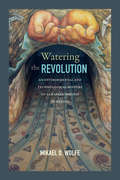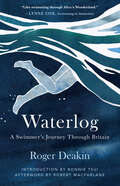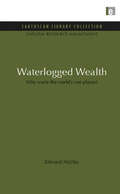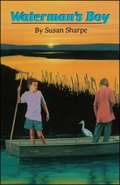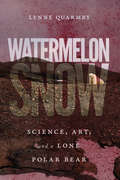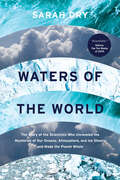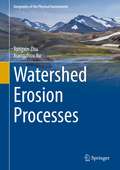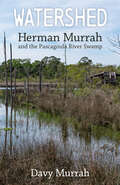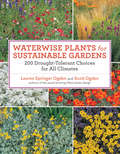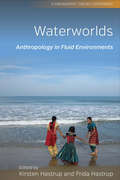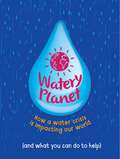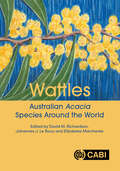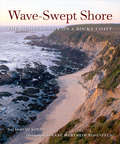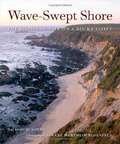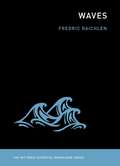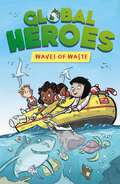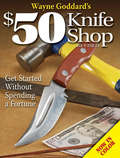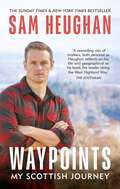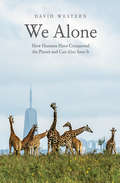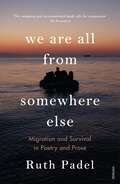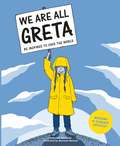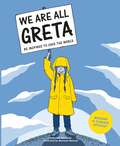- Table View
- List View
Watering the Revolution: An Environmental and Technological History of Agrarian Reform in Mexico
by Mikael D. WolfeIn Watering the Revolution Mikael D. Wolfe transforms our understanding of Mexican agrarian reform through an environmental and technological history of water management in the emblematic Laguna region. Drawing on extensive archival research in Mexico and the United States, Wolfe shows how during the long Mexican Revolution (1910-1940) engineers’ distribution of water paradoxically undermined land distribution. In so doing, he highlights the intrinsic tension engineers faced between the urgent need for water conservation and the imperative for development during the contentious modernization of the Laguna's existing flood irrigation method into one regulated by high dams, concrete-lined canals, and motorized groundwater pumps. This tension generally resolved in favor of development, which unintentionally diminished and contaminated the water supply while deepening existing rural social inequalities by dividing people into water haves and have-nots, regardless of their access to land. By uncovering the varied motivations behind the Mexican government’s decision to use invasive and damaging technologies despite knowing they were ecologically unsustainable, Wolfe tells a cautionary tale of the long-term consequences of short-sighted development policies.
Waterlog: A Swimmers Journey
by Roger Deakin“Like swimming through Alice’s Wonderland.” —Lynne Cox A swimming journey would give me access to that part of our world which, like darkness, mist, woods or high mountains, still retains most mystery. It would afford me a different perspective on the rest of land-locked humanity. A masterpiece of nature writing, Roger Deakin’s Waterlog is a fascinating and inspiring journey into the aquatic world that surrounds us. In an attempt to discover his island nation from a new perspective, Roger Deakin embarks from his home in Suffolk to swim Britain—the seas, rivers, lakes, ponds, pools, streams, lochs, moats, and quarries. Through the watery capillary network that braids itself throughout the country, Deakin immerses himself in the natural habitats of fish, amphibians, mammals, and birds. And as he navigates towns, private property, and sometimes dangerous waters and inclement weather, Deakin finds himself in precarious situations: he’s detained by bailiffs in Winchester, intercepted by the coast guard at the mouth of a river, and mistaken for a dead body on a beach. The result of this surprising journey is a deep dive into modern Britain, especially its wild places. With enchanting descriptions of natural landscapes, and a deep well of humanity, boundless humor, and unbridled joy, Deakin beckons us to wilder waters and inspires us to connect to the larger world in a most unexpected way. Thrilling, vivid, and lyrical, Waterlog is a fully immersive adventure—a remarkable personal quest, a bold assertion of the swimmer’s right to roam, and an unforgettable celebration of the magic of water.
Waterlogged Wealth: Why waste the world's wet places? (Natural Resource Management Set)
by Edward MaltbyDon't drain the swamp! Man's traditional response to swamps, marshes and bogs has been to drain them. But wetlands are not wastelands. Coastal marshes are among the world's most productive ecosystems. They make many commercial fisheries possible and protect coasts from floods and storm surges. Wetlands are pollution filters, water reservoirs. They are among the last wild places on earth, offering homes to endangered plants, birds and animals. Attitudes to wetlands are changing, but not fast enough. As scientists are documenting the wealth in wet places, governments and developers are draining them, damming them, logging them and building resort hotels where ', they once were. Destruction is usually a poor trade-off: well-managed wetlands in Louisiana are producing fortunes in seafood and timber. Waterlogged wealth examines the value of swamps and marshes, as well as the threats against them. In doing so it takes the reader to some of the world's most bizarre landscapes: the 'inland delta' of the Niger River in drought-stricken Mali; the wildlife-rich Okavango swamps of Botswana; the waterlogged Sunderban forests of India and Bangladesh, where tigers eat fish and crabs. Civilisation began around wetlands; today's civilisation has good reason to leave them wet and wild. Dr Edward Maltby is a lecturer in geography at the University of Exeter(UK). He has done extensive research on wetlands both in the North (UK, US, Canada) and the South (Fiji, Jamaica, India and the Falklands/Malvinas Islands). He is on the IUCN Wetland Programme Advisory Committee. Originally published in 1986
Waterman's Boy, 1st Edition
by Susan SharpeTwo boys from a small town on the Chesapeake Bay help a scientist interested in cleaning up the water for the benefit of animals, plants, and people, while risking parental disapproval of people with too much education and of outsiders' interference in their means of earning a living.Two boys from a small Chesapeake Bay town help a scientist interested in cleaning up the water to benefit animals, plants, and people, while risking disapproval of the local residents toward people with too much education and who interfere in their meansof earning a living.
Watermelon Snow: Science, Art, and a Lone Polar Bear
by Lynne QuarmbyConcern about the climate crisis is widespread as humans struggle to navigate life in uncertain times. From the vantage of a schooner full of artists on an adventure in the high Arctic, biologist Lynne Quarmby explains the science that convinced her of an urgent need to act on climate change and recounts how this knowledge - and the fear and panic it elicited - plunged her into unsustainable action, ending in arrests, lawsuits, and a failed electoral campaign on behalf of the Green Party of Canada. Watermelon Snow weaves memoir, microbiology, and artistic antics together with descriptions of a sublime Arctic landscape. At the top of the warming world, Quarmby struggles with burnout and grief while an aerial artist twirls high in the ship's rigging, bearded seals sing mournfully, polar bears prowl, and glaciers crumble into the sea. In a compelling narrative, sorrow and fear are balanced by beauty and wonder. The author's journey back from a life out of balance includes excursions into evolutionary history where her discoveries reveal the heart of human existence. The climate realities are as dark as the Arctic winter, yet this is a book of lightness and generosity. Quarmby's voice, intimate and original, illuminates the science while offering a reminder that much about the human experience is beyond reason. Inspiring and deeply personal, Watermelon Snow is the story of one scientist's rediscovery of what it means to live a good life at a time of increasing desperation about the future.
Waters of the World: The Story of the Scientists Who Unraveled the Mysteries of Our Oceans, Atmosphere, and Ice Sheets and Made the Planet Whole
by Sarah DryA Nature Top Ten Book of the Year: “Immensely readable” accounts of seven pioneers who were at the forefront of what we now call climate science (New York Review of Books).One of Booklist’s Top Ten Sci-Tech Books of the YearFrom the glaciers of the Alps to the towering cumulonimbus clouds of the Caribbean and the unexpectedly chaotic flows of the North Atlantic, Waters of the World is a tour through 150 years of the history of a significant but underappreciated idea: that the Earth has a global climate system made up of interconnected parts, constantly changing on all scales of both time and space. A prerequisite for the discovery of global warming and climate change, this idea was forged by scientists studying water in its myriad forms. This is their story.Linking the history of the planet with the lives of those who studied it, Sarah Dry follows the remarkable scientists who summited volcanic peaks to peer through an atmosphere’s worth of water vapor, cored mile-thick ice sheets to uncover the Earth’s ancient climate history, and flew inside storm clouds to understand how small changes in energy can produce both massive storms and the general circulation of the Earth’s atmosphere. Each toiled on his or her own corner of the planetary puzzle. Gradually, their cumulative discoveries coalesced into a unified working theory of our planet’s climate.We now call this field climate science, and in recent years it has provoked great passions, anxieties, and warnings. But no less than the object of its study, the science of water and climate is—and always has been—evolving. By revealing the complexity of this history, Waters of the World delivers a better understanding of our planet’s climate at a time when we need it the most.“One of the richest books I have ever read . . . a beautifully written, episodic, yet comprehensive, history of the diverse scientific underpinnings of climate science over the past two hundred years.” —Environmental History“Smart, compelling, and timely . . . By focusing on specific scientists, Dry gifts readers with entertaining portraits of some thoroughly interesting if largely unknown individuals.”—Booklist (starred review)
Watershed Erosion Processes (Geography of the Physical Environment)
by Xiangzhou Xu Tongxin ZhuThis monograph is a fundamental study of watershed erosion and runoff processes. It utilizes decades of soil erosion data to take a comprehensive and balanced approach in covering various watershed erosion processes. While there are many works on soil erosion and conservation, this book fills the gaps in previously published research by focusing more on mass movement, gully erosion, soil piping/tunnel erosion, and the spatial interactions of different erosion processes. Additionally, the book examines erosion processes in extreme rainfall events, something typically absent in short-term studies but discussed in detail here as the book draws on 60 years of research and observations, including 30 years of the author's own investigations of erosion under a wide range of rainfall conditions. The book is divided into 3 parts, and is intended for soil erosion researchers and practitioners, and postgraduate students studying soil erosion and water conservation. Part 1 opens with a comprehensive and critical review of existing literature on soil erosion processes, discusses this book's place among existing literature, and examines the major erosion processes (rainwash, gully erosion, tunnel erosion, and mass movements) including their controlling factors and mechanisms. Part 2 explores the spatial interactions of these different erosion processes to provide a prerequisite for effective design of comprehensive soil erosion control measures in a watershed. Part 3 evaluates the relative significance of these erosion processes in sediment production, the effectiveness of comprehensive soil and water conservation programs, and the applications of watershed modelling in determining the impact of land-use changes on soil erosion and other ecological processes.
Watershed: Attending to Body and Earth in Distress
by Ranae Lenor HansonA personal health crisis, stories from environmental refugees, and our climate in danger prompt a meditation on intimate connections between the health of the body and the health of the ecosystem The body of the earth, beset by a climate in crisis, experiences drought much like the human body experiences thirst, as Ranae Lenor Hanson&’s body did as a warning sign of the disease that would change her life: Type 1 diabetes. What if we tended to an ailing ecosystem just as Hanson learned to care for herself in the throes of a chronic medical condition. This is the possibility explored in a work that is at once a memoir of illness and health, a contemplation of the surrounding natural world in distress, and a reflection on the ways these come together in personal, local, and global opportunities for healing.Beginning with memories from a childhood nurtured among the waters of Minnesota, Watershed follows the streams and tributaries that connect us to our world and to each other, as revealed in the life stories of Hanson&’s students, Minnesotans driven from their faraway homelands by climate disruption. The book&’s currents carry us to threatened mangrove swamps in Saudi Arabia, to drought-stricken Ethiopia, to rocks bearing ancient messages above crooked rivers in northern Minnesota, to a diabetic crisis in an ICU bed at a St. Paul hospital. With the benefit of gentle insight and a broad worldview, Hanson encourages us at every turn to find our own way, to discover how the health of our bodies and the health of the world they inhabit are inextricably linked and how attending, and tending, to their shared distress can lead to a genuine, grounded wellbeing. When, in the grip of a global pandemic, humans drastically change their behavior to preserve human life, we also see how the earth breathes more freely as a result. In light of that lesson, Watershed helps us to consider our place and our part in the health and healing of the world around us.
Watershed: Herman Murrah and the Pascagoula River Swamp
by Davy MurrahThe Pascagoula River is the largest unobstructed river in the contiguous United States. Because of this lack of restraint, the river has been left to rise and fall naturally with the seasons, overflowing annually into the adjoining bottomland forest. This phenomenon makes the Pascagoula River one of the wildest rivers, surrounded by some of the most ecologically diverse woodlands, in North America.Herman Murrah (1935–2002) lived his entire life on the banks and in the swamp surrounding this river in southeast Mississippi. Watershed: Herman Murrah and the Pascagoula River Swamp recounts pivotal moments in Herman’s life and in Mississippi’s conservation history more broadly. In this book, Herman’s eldest son, Davy, details the adventures that continue to inspire young conservationists in the fight to protect our remaining natural ecosystems.As a young adult, Herman worked as a game warden in the Pascagoula River Swamp. When the Pascagoula Hardwood Company, then owners of the swamp, decided to sell the vast tract of forest for clearcutting, Herman was incensed. Determined to protect this natural wonder, Herman teamed up with other visionaries to persuade the State of Mississippi to purchase the land and preserve it in perpetuity to the benefit of future generations of humans and wildlife alike. Eventually, the state agreed and finalized the purchase. Herman was appointed area manager for the upper portion of the newly designated Pascagoula River Wildlife Management Area. He dedicated the remainder of his life to preserving, protecting, and improving the swamp for the good of south Mississippi.
Waterwise Plants for Sustainable Gardens: 200 Drought-Tolerant Choices for all Climates
by Scott Ogden Lauren Springer Ogden“I can't imagine a designer or avid gardener who wouldn't want this on their bookshelf.” —Garden Design OnlineWaterwise Plants for Sustainable Gardens is a practical guide to the best 200 plants guaranteed to thrive in low-water gardens. Plant entries provide the common and botanical name, the regions where the plant is best adapted, growth and care information, and notes on pests and disease. This practical and inspiring guide includes a variety of plants, from trees to succulents, perennials to bulbs, all selected for their wide adaptability and ornamental value. Companion plants, creative design ideas, and full color photography make this guide a must-have resource for any sustainable gardener.
Waterworlds: Anthropology in Fluid Environments
by Kirsten Hastrup Frida HastrupIn one form or another, water participates in the making and unmaking of people's lives, practices, and stories. Contributors' detailed ethnographic work analyzes the union and mutual shaping of water and social lives. This volume discusses current ecological disturbances and engages in a world where unbounded relationalities and unsettled frames of orientation mark the lives of all, anthropologists included. Water emerges as a fluid object in more senses than one, challenging anthropologists to foreground the mutable character of their objects of study and to responsibly engage with the generative role of cultural analysis.
Watery Planet: How a water crisis is impacting our world
by Anna ClaybourneWatery Planet offers young readers a clear, insightful look at Earth's ongoing water challenges.Water makes our life on Earth possible. We need water not just to drink and keep clean, but also for agriculture, industry, transport and much, much more. But despite having an enormous amount of water on Earth, only 1 per cent of it is available for us to use and it's at increasing risk.Watery Planet looks at the reasons behind our looming water crisis - from uneven distribution to water wastage, pollution and climate change. It explores how floods, droughts and rising sea levels are becoming a stark reality as the world warms and describes how we are adapting to these challenges. It also looks at some positive, practical solutions to our water problems and explains how we can all do our part to help save Earth's most precious resource.Contents:A WHOLE WORLD OF WATER WE ALL NEED WATER! HOW WE GET WATER IS THERE ENOUGH WATER? WATER AND HEALTH CASE STUDY: COLLECTING WATER IN ETHIOPIA WATER POLLUTION WATER AND GLOBAL WARMING FLOODS AND DROUGHTS CASE STUDY: PAKISTAN FLOODS RISING SEA LEVELS WATER AND NATURE WATER AND WILDLIFE CASE STUDY: THIRSTY AVOCADOS DOING THINGS DIFFERENTLY WATER FOR THE WORLD CASE STUDY: THE ARAL SEA WATERY HOMES WHAT CAN YOU DO? THE FUTURE OF WATER GLOSSARY FURTHER READING INDEX Titles in this series:Plastic PlanetHot PlanetRecycled PlanetSustainable PlanetExtinction PlanetPeaceful Planet?Unequal Planet
Wattles: Australian Acacia Species Around the World
by Stuart Hall Philip W. Rundel Richard Hill Libby Robin Michael Wingfield Charlie Shackleton John R. Wilson Petr Pyšek Philip E. Hulme Jane Carruthers Antoine Guisan Giuseppe Brundu Cang Hui Nuno Fernandes Guillaume Latombe Luís González Matt Ritter Dr Ross Shackleton Dr Aníbal Pauchard Narciso Aguilera Joaquim Alonso Samuel C. Andrew Irene Barnes Ashleigh M. Basel Rita Bastos Pierre Binggeli Rachel M. Binks Christophe Botella David Bush Dr Margaret Byrne João A. Cabral Laura Celesti-Grapow Julian M. Chan Roland Cochard M. Conceição Colaço Peter J. Cunningham Jorge Dias Catherine R. Dickson Liliana N. Duarte Allan G. Ellis Luís Fernandes Eduardo Fuentes-Lillo Andrés Fuentes-Ramírez Rachael V. Gallagher Rafael García Sjirk Geerts Michelle R. Gibson Margherita Gioria Catarina Gonçalves João Gonçalves Vinicius Paiva Gonçalves Pablo González-Moreno António Carmo Gouveia A. Rod Griffin André Große-Stoltenberg Greg R. Guerin Jane L. Harbard Gustavo Heringer Patricia M. Holmes João P. Honrado Brett P. Hurley Fiona Impson Cally Jansen Nolwethu Jubase-Tshali Jan-Hendrik Keet Rob Kelly Ian Kotze Christoph Kueffer Ingolf Kühn Dr Christian A. Kull Sabrina Kumschick Vitalis K. Lagat Bárbara Langdon David C. Le Maitre Ivan Lizarazo Francisco López-Núñez Paula Lorenzo Vanessa Lozano Sérgio Maggiolli Cristina Máguas Hélia Marchante Irene Martín-Forés Cecilia Masemola Bruce Maslin David J. Merritt Stephen J. Midgley Melissa A. Millar Carey Minteer Leonie T. Monks Nuno Mouta Jana Mullerova Daniel J. Murphy Silvia Neves Dung Tri Ngo Dr Ana Novoa Jens Oldeland Lucas Prado Osco Penelope P. Pascoe Thao Phuong Pham Eva M. Pinto Jorge E. Ramirez-Albores A. Tony Rinaudo James G. Rodger Mário Santos Iryna Skulska Canh Quoc Tran Thang Nam Tran Helena Trindade Florian Ulm Van Thi Hai Dr Brian Van Wilgen Maribel Vásquez-Valderrama A. Sofia Vaz Joana R. Vicente Sara Vicente Elizabeth M. Wandrag Andrew Wannenburgh Christiane Werner Rafael Dudeque ZenniThe book provides a comprehensive overview of current knowledge about "wattles", a large clade of over 1000 species of trees and shrubs in the genus Acacia, most of which are native to Australia. It examines the biology, ecology, evolution, and biogeography of wattles in their native ranges, including the evolutionary forces that have driven past speciation and adaptation to diverse environments, the conservation status, uses and human perceptions of these species. It considers the different histories of the introductions and proliferation of wattles as alien species in different parts of the world since c. 1850 (the Anthropocene), situated within relevant political, socio-economic and scientific contexts, together with an analysis of how awareness of their impacts as invasive species has changed over time. Differences in the dynamics and trends associated with the introduction, naturalization and invasion of wattles in different parts of the world are reviewed. The book also synthesizes the global distribution of wattles using diverse data sources, alongside trends, patterns and projections of global uses of wattles. It discusses the genetics, biotic interactions, and ecological, economic and social impacts of invasive wattles. - The first comprehensive global synthesis in book form of aspects of the biology, ecology, biogeography and management of one of the world's most important woody plant genera. - Provides the foundation for the assessment of evidence-based information required to formulate sustainable management strategies for non-native plants that have both benefits and negative impacts. - Sheds new light on many aspects of plant invasion science. This book is aimed at academics and students in the field of ecology, and at managers of natural and anthropic ecosystems, policy-makers and regulators, and the general public interested in biology and environmental science.
Wave-Swept Shore: The Rigors of Life on a Rocky Coast
by Dr. Mimi A. KoehlTake a close look at a wave-battered coast and you will discover a rich, fascinating, and remarkably brutal environment. Here, animals and plants exposed to wind, sun, and rain at low tide must cope with crashing waves as the seas rise to submerge them each day at high tide. How do living things survive in this harsh zone? With 87 stunning color photographs and an engaging text written for those with little or no knowledge of marine biology or physics, this book tells the story of one stretch along the Pacific coast of North America—introducing the mussels, limpets, crabs, grasses, starfish, kelp, and other animals and plants that live there, and explaining how they function and flourish in an environment of waves, sand, and rocks.In pictures and words, Wave-Swept Shore explains complex phenomena, such as wave action, using simple, intuitive analogies. It explores how the forms of animals and plants affect their survival in this harsh environment, considers their distribution on the shore, and looks at their seasonal variations, focusing on what can be easily observed by visitors to the coast. Revealing the rich variety of habitats woven into what may at first look like a fairly uniform environment, the book, an effective and beautiful tool for learning about the edge of oceans everywhere, opens our eyes to the wonders of rocky shores and introduces a whole new way of looking at the natural world.
Wave-Swept Shore: The Rigors of Life on a Rocky Coast
by Mimi KoehlThis book tells the story of one stretch along the Pacific coast of North America--introducing the mussels, limpets, crabs, grasses, starfish, kelp, and other animals and plants that live there, and explaining how they function and flourish in an environment of waves, sand, and rocks.
Waves
by Fredric RaichlenSitting on the beach on a sunny summer day, we enjoy the steady advance and retreat of the waves. In the water, enthusiastic waders jump and shriek with pleasure when a wave hits them. But where do these waves come from? How are they formed and why do they break on the shore? In Waves, Fredric Raichlen traces the evolution of waves, from their generation in the deep ocean to their effects on the coast. He explains, in a way that is readily understandable to nonscientists, both the science of waves themselves and the technology that can be used to protect us against their more extreme forms, including hurricanes and tsunamis. After offering a basic definition of waves and explaining the mechanics of wind-wave generation, Raichlen describes how waves travel, how they shoal (rise), how they break, and how they transform in other ways. He goes on to describe, among other things, the complicated sun-Earth-moon combinations that create astronomical tides (the high and low tides that occur daily and predictably); the effects of waves on the beach, including rip currents and beach erosion, and on harbors and shipping; and the building of breakwaters to protect harbors and bays. He discusses hurricanes, storm surges, and hurricane-generated waves. He offers a brief history of tsunamis, including Sumatra's in 2004 and Japan's in 2011, and explains the mechanisms that generate them (including earthquakes, landslides, and volcanoes). Waves can be little ripples that lap peacefully at the shore or monstrous tsunamis that destroy everything in their paths. Describing the science underlying this astonishing variety, Waves offers a different kind of beach reading.
Waves of Waste (Global Heroes #1)
by Damian HarveyJoin our team of Global Heroes in this fast-paced, science-themed chapter book as they aim to rid the seas of the rising pollution and waste, but must also navigate deadly dangers from sea predators... Great for readers age 7+ these adventure stories are also full of fascinating facts. These illustrated chapter books are perfect for making fascinating science topics accessible to young readers, inspiring a thirst for knowledge and learning by stealth. The team of characters come from around the world to give a truly global outlook.
Wayne Goddard's $50 Knife Shop, Revised
by Wayne GoddardDon't spend big bucks on your knife shop! You don't need to spend a fortune to start making fantastic knives. Noted knifemaker Wayne Goddard provides outstanding step-by-step instructions for making your own tools, finding the right steel and forging, grinding and heat-treating knives on a budget. Wonderfully illustrated with full-color photography, Goddard's book guides you through the knifemaking process from start to finish and even includes a budget breakdown showing everything you need is available to bargain prices. Goddard even explains and demonstrates the making of wire Damascus blades with the simplest of tools. Wayne Goddard's $50 Knife Shop is a find companion volume to Goddard's book The Wonder of Knifemaking and provides all the details you need to start making knives on a budget.
Waypoints: My Scottish Journey
by Sam HeughanAN INSTANT SUNDAY TIMES AND NEW YORK TIMES BESTSELLER'As the title suggests, Waypoints is a rewarding mix of markers, both personal as he reflects on his life and geographical as he leads the reader along the West Highland Way' - The Scotsman'A deeply personal and warmly entertaining memoir that fans of Sam - and Scotland - will have a joyful time devouring' - Heat'From both his walk and his career, the common lesson is the power of persistence.' - The Times'A pleasure for fans of the author, whisky, and Scotland.' - Kirkus'Waypoints is a memoir with a difference! I wanted to tell the stories and share the experiences that have shaped me, but to do that I needed to challenge myself and spend some time in my own company, away from the distractions of everyday life. And for me there's no better place to reflect than in the wild Scottish Highlands.'In this journey of self-discovery, Sam Heughan sets out along the West Highland Way to explore his heritage and reflect on the personal waypoints that define him. The result is a love letter to the wild Scottish landscape that means so much to Sam, and a charming, funny, wise and searching insight to the world through his eyes. The walk itself is the backdrop for this narrative, which tells the story of Sam's life while exploring his outlook, values and interests. Sam is a figure of fascinating contrasts, a Hollywood star with deep roots in rural Scotland, he's both outgoing and content in his own company. He has strong connections with his fans while recognising the fragility and value of anonymity, and in My Peak Challenge he has created a network that brings people together as they chase individual goals. In his new book, while charting a path through a stunning wilderness, Sam maps out the moments that shaped his views on dreams and ambition, family, friendships, love and life.Waypoints is a deeply personal journey that reveals as much to Sam about himself as it does to his readers.
We Alone: How Humans Have Conquered the Planet and Can Also Save It
by David WesternA thoughtful exploration of how humans have endangered the Earth but can pull it back from the brink, as told by a renowned conservationist This personal and thoughtful book by renowned Kenya conservationist David Western traces our global conquest from Maasai herders battling droughts in Africa to the technological frontiers of California. Western draws on a half century of research in the savannas and his own life’s journey to argue that conservation is not a modern invention. The success of all societies past and present lies in conservation practices, breaking biological barriers and learning to live in large cooperative groups able to sustain a healthy environment. Our ecological emancipation from nature enabled us to expand our horizons from conserving food and water for survival to saving whales, elephants, and our cultural heritage. In the Anthropocene, our scientific knowledge and modern sensibilities offer hope for combating global warming and creating a planet able to sustain the wealth of life, but only if we use our unique cultural capacity of cooperation to plan our future.
We Are All From Somewhere Else: Migration and Survival in Poetry and Prose
by Ruth Padel*First published as The Mara Crossing, now with new and updated material*'A prodigy, a book of wonders. Wonder, pity and terror, the searing section of voices in transit coercing compassion - and beyond that, empathy' IndependentHome is where you start from, but where is a swallow's real home? And what does 'native' mean if the English oak is an immigrant from Spain?In ninety richly varied poems and illuminating prose interludes, Ruth Padel weaves science, myth, wild nature and human history to conjure a world created and sustained by migration - from the millennia-old journeys of cells, trees, birds and beasts to Geese battle raging winds over Mount Everest, lemurs skim precipices in Madagascar and wildebeest, at the climax of their epic trek from Tanzania, braving a river filled with the largest crocodiles in Africa. Human migration has shaped civilisation but today is one of the greatest challenges the world faces. In a series of incisive portraits, Padel turns to the struggles of human displacement - the Flight into Egypt, John James Audubon emigrating to America (feeding migrant birds en route), migrant workers in Mumbai and refugees labouring over a drastically changing planet - to show how the purpose of migration, for both humans and animals, is survival.
We Are All Greta: Be Inspired By Greta Thunberg To Save The World
by Valentina Giannella"Humans are very adaptable: We can still fix this. But the opportunity to do so will not last for long. We must start today. We have no more excuses" GRETA THUNBERGFollow in the footsteps of the Swedish teenage activist and Nobel Peace Prize candidate in We Are All Greta and join the global mission to save our planet from climate change. Greta Thunberg, author of No One is too Small to Make a Difference, has directed the attention of adults and her peers alike to issues crucial to the future of the planet, and the heads of even the youngest children have been filled with questions. GLOBAL WARMING, THE GREENHOUSE EFFECT, FOSSIL FUELS - what do they all mean? What are biodiversity and sustainable development? Who is studying the changes that are taking place here on Earth? Which sources are reliable? What action can I take?We Are All Greta sets out the basic ideas required to understand climate change, explained in a scientific and accessible way and drawn from the most authoritative sources. With a chapter on key words and sites to help you understand the climate challenge and a list of websites to visit for further information, this is a book for young people, for parents, for grandparents and anyone having to answer direct and urgent questions about what must be done to protect our world.WHAT EARLY READERS ARE SAYING ABOUT WE ARE ALL GRETA"Very good for young & older readers. This applies to every one of us on this planet!""Since we have only about 12 years before climate change is irreversible, this is a very timely book. Highly recommended.""It is suitable for children and adults alike and I would recommend it to anyone wanting to learn more about global warming.""Definitely a good place to start when teaching kids about the environment."
We Are All Greta: Be Inspired to Save the World
by Valentina GiannellaHumans are very adaptable: We can still fix this. But the opportunity to do so will not last for long. We must start today. We have no more excuses'GRETA THUNBERGFollow in the footsteps of the Swedish teenage activist and Nobel Peace Prize candidate in We Are All Greta and join the global mission to save our planet from climate change.Greta Thunberg, author of No One is too Small to Make a Difference, has directed the attention of adults and her peers alike to issues crucial to the future of the planet, and the heads of even the youngest children have been filled with questions. GLOBAL WARMING, THE GREENHOUSE EFFECT, FOSSIL FUELS - what do they all mean? What are biodiversity and sustainable development? Who is studying the changes that are taking place here on Earth? Which sources are reliable? What action can I take?We Are All Greta sets out the basic ideas required to understand climate change, explained in a scientific and accessible way and drawn from the most authoritative sources. With a chapter on key words and sites to help you understand the climate challenge and a list of websites to visit for further information, this is a book for young people, for parents, for grandparents and anyone having to answer direct and urgent questions about what must be done to protect our world.WHAT EARLY READERS ARE SAYING ABOUT WE ARE ALL GRETA'Will enable readers to understand the climate emergency and learn what can be done to help. Highly illustrated, and with clear, in-depth text and data, it will answer young readers' questions on what climate change means, what its consequences will be, and what must be done to protect our world'LOVEREADING4KIDS BOOK OF THE MONTH'A must-read book for all the citizens of Earth! You want to save Earth and all in it, stop complaining and start saving''A really informative and helpful book that is suitable for both adults and older kids. It was the perfect length and took the time it needed to get the message across without bogging us down''Managed to explore a lot of issues in an accessible way, with a great glossary at the end, and also managed to make points without being too scary, preachy or didactic - no mean feat in this field'
We Are All Greta: Be Inspired to Save the World
by Valentina GiannellaHumans are very adaptable: We can still fix this. But the opportunity to do so will not last for long. We must start today. We have no more excuses'GRETA THUNBERGFollow in the footsteps of the Swedish teenage activist and Nobel Peace Prize candidate in We Are All Greta and join the global mission to save our planet from climate change.Greta Thunberg, author of No One is too Small to Make a Difference, has directed the attention of adults and her peers alike to issues crucial to the future of the planet, and the heads of even the youngest children have been filled with questions. GLOBAL WARMING, THE GREENHOUSE EFFECT, FOSSIL FUELS - what do they all mean? What are biodiversity and sustainable development? Who is studying the changes that are taking place here on Earth? Which sources are reliable? What action can I take?We Are All Greta sets out the basic ideas required to understand climate change, explained in a scientific and accessible way and drawn from the most authoritative sources. With a chapter on key words and sites to help you understand the climate challenge and a list of websites to visit for further information, this is a book for young people, for parents, for grandparents and anyone having to answer direct and urgent questions about what must be done to protect our world.WHAT EARLY READERS ARE SAYING ABOUT WE ARE ALL GRETA'Will enable readers to understand the climate emergency and learn what can be done to help. Highly illustrated, and with clear, in-depth text and data, it will answer young readers' questions on what climate change means, what its consequences will be, and what must be done to protect our world'LOVEREADING4KIDS BOOK OF THE MONTH'A must-read book for all the citizens of Earth! You want to save Earth and all in it, stop complaining and start saving''A really informative and helpful book that is suitable for both adults and older kids. It was the perfect length and took the time it needed to get the message across without bogging us down''Managed to explore a lot of issues in an accessible way, with a great glossary at the end, and also managed to make points without being too scary, preachy or didactic - no mean feat in this field
We Are All Greta: Be Inspired to Save the World
by Valentina GiannellaHumans are very adaptable: We can still fix this. But the opportunity to do so will not last for long. We must start today. We have no more excuses'GRETA THUNBERGFollow in the footsteps of the Swedish teenage activist and Nobel Peace Prize candidate in We Are All Greta and join the global mission to save our planet from climate change.Greta Thunberg, author of No One is too Small to Make a Difference, has directed the attention of adults and her peers alike to issues crucial to the future of the planet, and the heads of even the youngest children have been filled with questions. GLOBAL WARMING, THE GREENHOUSE EFFECT, FOSSIL FUELS - what do they all mean? What are biodiversity and sustainable development? Who is studying the changes that are taking place here on Earth? Which sources are reliable? What action can I take?We Are All Greta sets out the basic ideas required to understand climate change, explained in a scientific and accessible way and drawn from the most authoritative sources. With a chapter on key words and sites to help you understand the climate challenge and a list of websites to visit for further information, this is a book for young people, for parents, for grandparents and anyone having to answer direct and urgent questions about what must be done to protect our world.WHAT EARLY READERS ARE SAYING ABOUT WE ARE ALL GRETA'Will enable readers to understand the climate emergency and learn what can be done to help. Highly illustrated, and with clear, in-depth text and data, it will answer young readers' questions on what climate change means, what its consequences will be, and what must be done to protect our world'LOVEREADING4KIDS BOOK OF THE MONTH'A must-read book for all the citizens of Earth! You want to save Earth and all in it, stop complaining and start saving''A really informative and helpful book that is suitable for both adults and older kids. It was the perfect length and took the time it needed to get the message across without bogging us down''Managed to explore a lot of issues in an accessible way, with a great glossary at the end, and also managed to make points without being too scary, preachy or didactic - no mean feat in this field'
